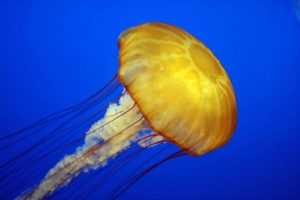
Costa Rica. For millions of tourists, the name brings to mind images of great beaches, impressive landscapes, and amazing biodiversity. The country offers all that and then some. But this “paraíso tropical” also has its share of bothersome and even dangerous denizens. There are several creepy crawlies and other animals, big and small, that people should be wary of. One of these animals is the jellyfish.
Known in Spanish by several different names: aguamala, Medusa, “Hilo de Oro”, jellyfish are an ancient (+500 million-year-old) group of animals. They inhabit every ocean on the planet. They do not have a brain, skeleton, nervous system, heart or eyes. Some of them look like beautiful, delicate, colorful baubles. Jellyfish eat zooplankton, fish and other jellyfish, which they hunt using tentacles covered with stinging, venomous cells (called cnidocysts). We are not their prey. So far so good.
What makes jellyfish a problem for us? When we go up close and personal with them things can get dangerous. Why? All jellyfish contain poison, and while some jellyfish can give us a nasty, painful rash, others pack enough toxins in their tentacles to kill a human being really quick. Among the deadliest varieties are Box Jellyfish (Chironex fleckeri), Irukandji Jellyfish (Carukia barnesi), Portuguese Man o’ War (Physalia physalis), Sea Nettle (Chrysaora quinquecirrha).
Some Facts

– Most jellyfish live in the sea, but there are also freshwater species.
– They come in a variety of sizes. The Nomura jellyfish, with up to 2 m in diameter and weighing up to 200 kg vies with the lion’s mane jellyfish for the record of the world’s largest jellyfish.
– The smallest jellyfish is the Australian Irukandji (Carukia barnesi). Its body measures only 1.5 cm, but its tentacles can be more than 80 cm long. The amount of toxins it contains is enough to kill several grown-up men. With an average of 50 to 100 people poisoned every year, it is probably the deadliest of them all.
– In China, jellyfish are very popular as delicacies, especially along the eastern and southern coasts of the Asian nation. They are expensive and this has caused the appearance of a lucrative black market that produces tons of fake jellyfish. This product is dangerous to people’s health.
– Several years ago a spike in the population of jellyfish forced authorities to stop a nuclear plant in the United Kingdom. Masses of jellyfish clogged the cooling water filters the reactor needed to function properly.
– Jellyfish have turned a saltwater lagoon in the interior of an island in the Republic of Palau into a prime diving spot. These jellyfish’s stinging cells are so small that they are not capable of piercing human skin and people can safely swim with the animals.
– In 2007, marine biologists discovered a unique place, El Campo de las Medusas. Located at a depth of 2,500 meters off Costa Rica’s Pacific coast, the ocean floor is covered with pink jellyfish. They lay around a submarine thermal chimney that spews nutrients many marine animals thrive on.
– Some species of sea turtles have developed adaptations that allow them to consume jellyfish and not be affected by their venom. Leatherback sea turtles, for instance, eat only jellyfish (up to their own body weight daily).
What To Do If Stung

An encounter with an “aguamala” could ruin your holidays. Even though most of the jellyfish that are found in Costa Rica’s waters are not among the really poisonous, a number of people are stung every year. Symptoms vary from lingering pain and burn-like scars to respiratory problems and hemorrhages. In some extreme cases, these problems could be life-threatening, depending on the victim’s health, age and the type of jellyfish they’ve run into.
– Popular remedies include rubbing the site with hot sand (a no-no), peeing on it or applying vinegar or alcohol. Any of these hacks should be taken with a grain of salt as they could speed up the release of more toxins.
– In case of a sting, the victim should get out of the water and remove the tentacles with gloves or tweezers and seek medical attention as soon as possible.
– If you’re planning on visiting any locations where jellyfish have been reported, pay attention to the safety warnings. Usually, the locals know when it is not a good idea to enter the water.
– Another important advice is never to touch a jellyfish, even if it is out of the sea and seems dead since the stinging cells of its filaments remain active.
– Take into account that there is no 100% jellyfish free beach anywhere in the world.

